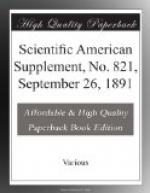Cailletet’s Cryogen.—A description, with one engraving, of Mr. Cailletet’s new apparatus for producing temperatures from 70 degrees to 80 degrees C., below zero, through the expansion of liquid carbonic acid
IX. Technology.—The Manufacture
of Roll Tar Paper.—An extended
article containing
a historical sketch and full information
as to the materials
used and the methods of manufacture
Smokeless Gunpowder.—By Hudson Maxim.—A comprehensive article on the manufacture and use of smokeless gunpowder, giving a sketch of its history, and describing the methods of manufacture and its characteristics
Method of Producing
Alcohol.—A description of an improved
process for making
alcohol.—Invented by Mr. Alfred Springer,
of Cincinnati,
Ohio
* * * * *
[Illustration: Interior of the new labor Exchange, Paris.]
[Illustration: New labor Exchange, Paris.]
The new labor Exchange, Paris.
The new Labor Exchange is soon to be inaugurated. We give herewith a view of the entrance facade of the meeting hall. The buildings, which are the work of Mr Bouvard, architect, of the city of Paris, are comprised within the block of houses whose sharp angle forms upon Place de la Republique, the intersection of Boulevard Magenta and Bondy street. One of the entrances of the Exchange is on a level with this street. The three others are on Chateau d’Eau street, where the facade of the edifice extends for a length of one hundred feet. From the facade and above the balcony that projects from the first story, stand out in bold relief three heads surrounded by foliage and fruit that dominate the three entrance doors. These sculptures represent the Republic between Labor and Peace. The windows of the upper stories are set within nine rows of columns, from between the capitals of which stand out the names of the manufacturers, inventors, and statesmen that have sprung from the laboring classes. Upon the same line, at the two extremities of the facade, two modillions, traversed through their center by palms, bear the devices “Labor” and “Peace.” Above, there is a dial surmounted by a shield bearing the device of the city of Paris.
The central door of the ground floor opens upon a large vestibule, around which are arranged symmetrically the post, telegraph, telephone, and intelligence offices, etc. Beyond the vestibule there is a gallery that leads to the central court, upon the site of which has been erected the grand assembly hall. This latter, which measures 20 meters in length, 22 in width, and 6 in height, is lighted by a glazed ceiling, and contains ten rows of benches. These latter contain 900 seats, arranged in the form of circular steps, radiating around the president’s platform,




